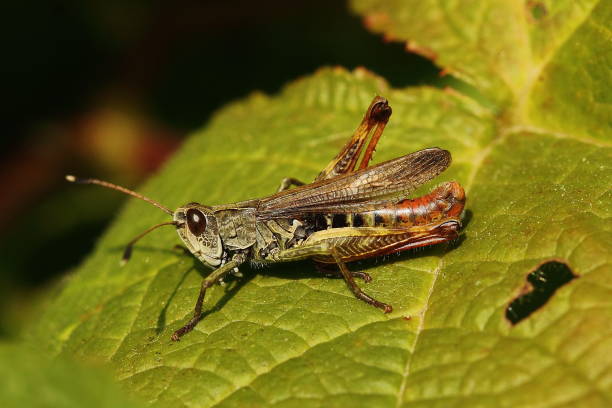Red-legged Grasshopper: The Scarlet-Jointed Jumper of North America
Table of Contents
Scientific Classification
| Kingdom | Animalia |
| Phylum | Arthropoda |
| Class | Insecta |
| Order | Orthoptera |
| Family | Acrididae |
| Genus | Melanoplus |
| Species | Melanoplus femurrubrum |
| ScientificName | Melanoplus femurrubrum |
Description
The Red-legged Grasshopper (Melanoplus femurrubrum) is a well-known species found throughout North America. Its name comes from its striking reddish hind legs. The various shades of brown, green, and yellow on its body help it camouflage perfectly among the grasses.
Typically, these grasshoppers measure between 2 to 3 cm long, with males being a bit smaller than females. Their hind femora are not only robust but also a vivid red. The rest of their bodies often feature subtle stripes or spots. With fully developed wings that extend beyond their abdomen, they are capable of flight. They also possess large compound eyes, long antennae, and strong mandibles—each of these traits has evolved to help them thrive in open fields.
Despite their unassuming appearance, these insects play a crucial role in grassland ecosystems and agricultural settings.
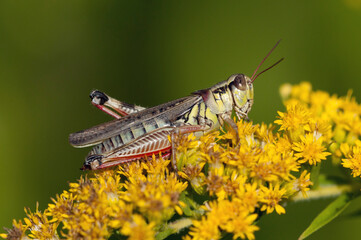
Distribution
The Red-legged Grasshopper is known for having one of the broadest ranges among grasshoppers in North America. You can typically find it in various places, including:
– Across the United States, particularly in the Midwest, Southeast, and Northeast
– Throughout southern Canada
– Down into northern Mexico
This grasshopper thrives at elevations from sea level up to over 2,000 meters, preferring temperate regions with grassy or semi-open areas. M. femurrubrum is quite adaptable and reproduces rapidly, allowing it to flourish in both wild and agricultural settings. This adaptability can have an impact on local biodiversity and crop yields.
Habitat
This species shows an impressive adaptability when it comes to its habitat. You can often spot it in:
– Meadows and grasslands
– Roadsides and pastures
– Lawns, gardens, and fields
– Agricultural areas, like corn and alfalfa fields
Red-legged grasshoppers really enjoy sunny, open spaces. They flourish in places with abundant vegetation and less competition for room. You won’t find them much in thickly wooded areas, but they do quite well in disturbed or human-altered environments.
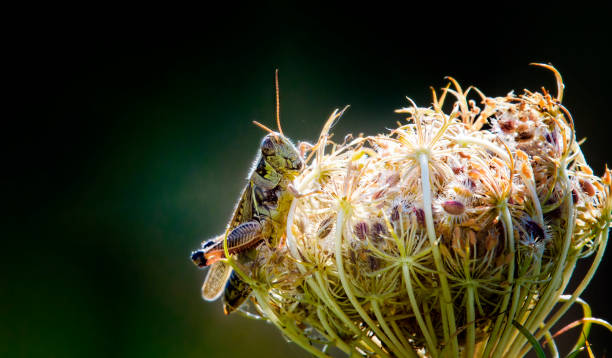
Diet
Melanoplus femurrubrum, commonly known as the red-legged grasshopper, is quite the adaptable eater. Being a polyphagous herbivore means it enjoys a diverse diet, which includes:
– Grasses, whether they’re native or invasive
– Forbs, which are those lovely herbaceous flowering plants
– Crop plants like alfalfa, clover, corn, wheat, and soybeans
– Leafy weeds and even garden veggies
With its strong mandibles, it can tackle tough plant fibers with ease. While it has a preference for grasses, it won’t hesitate to munch on whatever plants are nearby. This adaptability allows it to flourish in various environments. However, when their numbers swell, they can turn into a significant agricultural nuisance.
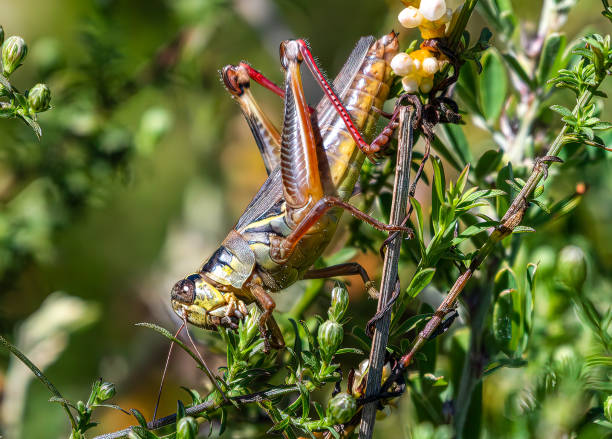
Behavior
The red-legged grasshopper may be small, but it boasts a variety of behaviors that help it survive and thrive.
Locomotion
This little guy is quite the jumper, using its powerful hind legs to leap several feet into the air. Adults are also capable fliers, covering short distances to dodge predators or travel between food sources.
Diurnal Activity
These grasshoppers are most lively during the day, especially when the sun is shining bright and the weather is warm.
Thermoregulation
To regulate their body temperature, they bask in the sun to warm up. When they start to feel too hot, they seek out shade to cool down. This behavior is crucial for keeping their body functions in check.
Gregarious but not Swarming
While red-legged grasshoppers tend to gather in groups, they don’t swarm like locusts. That said, when populations reach high densities, they can still cause notable damage to crops.
Lifespan
The average lifespan of a red-legged grasshopper is around:
Egg to Adult: 3 to 5 months
Adult lifespan: 2 to 3 months
In colder areas, you typically see just one generation each year. The eggs laid in the fall will hibernate in the soil and then hatch in the spring. However, in warmer southern regions, you might find two or even more generations popping up each year. Environmental factors like temperature and food availability play a big role in how they develop and how long they live.
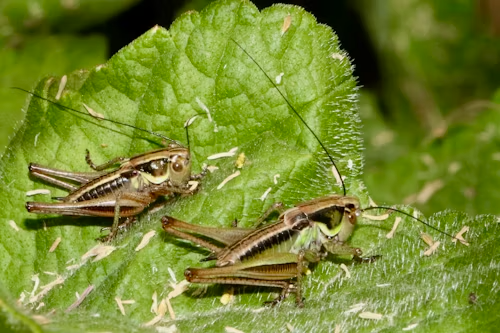
Reproduction and Lifecycle
Melanoplus femurrubrum goes through an incomplete metamorphosis, moving through three key stages:
1. Egg
During late summer or fall, females use a short ovipositor to lay clusters of 20 to 50 eggs in the soil. These egg pods are nestled in soft, moist earth just beneath the surface.
2. Nymph
Come spring or early summer, nymphs make their debut. They look like tiny adults but don’t have wings or sexual organs yet. Over the course of 5 to 6 molts, nymphs grow larger and more complex.
3. Adult
After their final molt, usually in midsummer, they reach sexual maturity. Adults can live for several weeks to a few months, during which they feed and reproduce. The eggs laid in late summer will overwinter and kick off the cycle again the following spring.
Predators
Predators play a significant role in the life of the red-legged grasshopper, making it a key food source in various ecosystems. Some of its common predators include:
– Birds: Blackbirds, sparrows, and hawks
– Reptiles: Garter snakes and lizards
– Mammals: Skunks, raccoons, and shrews
– Amphibians: Toads and frogs
– Invertebrates: Praying mantises, spiders, and assassin bugs
– Parasitoids: Certain flies and wasps that lay their eggs in or on grasshopper bodies
To defend themselves against these predators, grasshoppers use strategies like camouflage, quick flights, and unpredictable jumping. Nymphs, being smaller and wingless, are particularly at risk.

Nest
The red-legged grasshopper doesn’t make nests like other animals. However, people often call the spot where it lays eggs a “nest.”” These are:
- Shallow depressions in soft soil
- Protected by vegetation or placed near grass tufts
- Filled with egg pods and sealed with a frothy secretion that hardens into a protective plug
These nests provide a safe and warm place for the next generation to grow during winter.
Adaptations
The red-legged grasshopper has developed a variety of clever adaptations that boost its chances of survival:
1. Cryptic Coloration
Its mottled brown and green hues help it blend seamlessly into its surroundings, making it harder for predators to spot.
2. Leaping Legs
With its powerful femora, this grasshopper can leap impressively, allowing it to dodge threats and access different food sources.
3. Mandibles
Its sharp, robust jaws are perfect for munching on plants and can tackle a range of vegetation types.
4. Wing Development
Adult grasshoppers have long, membranous wings that allow for short flights, which are essential for spreading out and finding new habitats.
5. Diapause
During winter, the eggs can pause their development in a state known as diapause, ensuring they survive until the warmer spring months.
6. Behavioral Thermoregulation
By sunbathing or seeking shade, these grasshoppers can effectively manage their body temperature in fluctuating climates.
Mating Season
The mating season for Melanoplus femurrubrum occurs in mid-summer, typically from:
- June to September, depending on the region
Males court females by getting close and using touch. They tap with their antennae and legs. No elaborate songs or chirps—unlike other Orthopterans—are used in this courtship.
Mating lasts up to an hour once accepted. During this time, sperm transfers through a spermatophore.

Breeding
After mating, the female stores sperm and begins laying eggs within a few days. Breeding is prolific:
- A single female may lay hundreds of eggs over her lifetime
- Multiple egg pods are deposited during late summer or early fall
Moisture and temperature strongly influence egg viability. In places with enough rain and mild temperatures, eggs survive well. This leads to big population increases the next season.
This species can quickly become a pest in farms because it reproduces rapidly.
Interesting Facts
- Red Legs as a Warning: The bright hind legs can distract or confuse predators when the animal jumps.
- Insect Thermometers: Grasshoppers, like crickets, become more active when it’s warmer. They chirp and jump more as the temperature rises.
- Wings Beat While Jumping: Grasshoppers flap their wings while jumping. This helps them lift off and stay in the air longer.
- Cannibalistic Tendencies: Grasshoppers might eat each other when protein is low, even if they are the same species.
- Red-legged grasshoppers grow quickly. In perfect conditions, they can go from egg to adult in less than two months.
- Agricultural Impact: In outbreak years, they can cut crop yields by 20–30%, mostly in the Midwest.

Conservation Status
The Red-legged Grasshopper isn’t facing extinction. Conservation organizations have labeled it as a species of Least Concern. Thanks to its remarkable adaptability, wide-ranging habitat, and impressive reproduction rates, it continues to thrive in healthy numbers.
Threats
Pesticides: While they’re used to manage outbreaks, they often end up harming other species that weren’t the target.
Habitat Conversion: Urban sprawl is encroaching on meadows and native grasslands, which diminishes available nesting sites.
Management and Control
– Integrated Pest Management (IPM)
– Habitat Monitoring
– Biological Control Agents, such as parasitic flies and fungi
Melanoplus femurrubrum isn’t in immediate peril. Still, it plays a dual role in North America’s evolving landscapes, acting as both an ecological ally and an agricultural foe.
The red-legged grasshopper is more than just a summer chirper; it’s a resilient survivor, a vital prey species, and an essential component of various ecosystems. Its striking legs are just one of the many traits that make it a remarkable insect.


